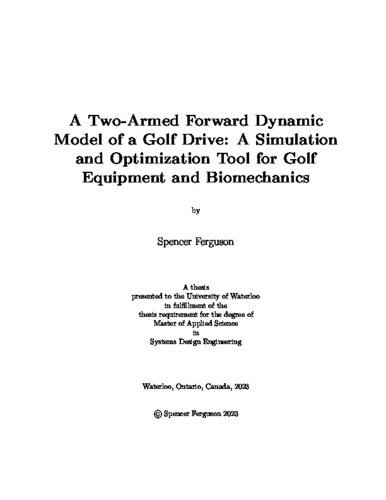UWSpace will be migrating to a new version of its software from July 29th to August 1st. UWSpace will be offline for all UW community members during this time.
A Two-Armed Forward Dynamic Model of a Golf Drive: A Simulation and Optimization Tool for Golf Equipment and Biomechanics
| dc.contributor.author | Ferguson, Spencer | |
| dc.date.accessioned | 2023-04-27 13:24:58 (GMT) | |
| dc.date.available | 2023-08-26 04:50:05 (GMT) | |
| dc.date.issued | 2023-04-27 | |
| dc.date.submitted | 2023-04-18 | |
| dc.identifier.uri | http://hdl.handle.net/10012/19337 | |
| dc.description.abstract | Golf club manufacturers and golf’s governing bodies both have clear interests in understanding how equipment design changes affect the performance of a golfer. Traditionally, to capture this interaction it was necessary to engage in time-consuming and expensive experimental testing. With the comprehensive modeling and computing tools available today, an opportunity exists to develop a forward dynamic model of a golf drive that can perform much of this testing in a virtual environment using predictive dynamic simulations. The experimentally-validated novel forward dynamic model developed in this thesis is a synthesis of four sub-models: a two-armed model of the golfer with 13 individual biomechanical joints, a continuous analytical flexible shaft model based on a Rayleigh beam formulation, an adjusted impulse-momentum clubhead-ball impact model, and a golf ball aerodynamic model. In concert, these sub-models combine to fully simulate a golf drive from biomechanics to ball flight. Experimental validation of the model was aided by the completion of a motion capture experiment in which the biomechanics, club kinematics, and ball launch conditions of ten elite golfers were quantified using three unique drivers. To validate the shaft model, the grip kinematics of a training dataset of experimental swings were used to drive an isolated model of the club while stiffness properties were tuned to minimimize the difference between simulated and experimental clubhead deflection. The golf ball aerodynamic model was validated using a set-aside training dataset of launch conditions and ball flights, showing excellent agreement and marked improvement over previous spin-rate dependent models. The biomechanical timings of the full model were optimized subject to a cost function maximizing carry distance while penalizing shots hit sufficiently far offline. Comparing the optimized swing to the biomechanics of the motion capture study participants showed that the model successfully reproduces swing traits of elite golfers. Additionally, the resultant ball speeds of the model closely matched the median of the experimental participants. Using the validated model, a series of “what-if?” predictive dynamic simulation experiments were performed. Pertinent findings related to golf’s distance debate included the positive correlation between both club and tee length and driving distance. The effects of wind on optimal golf drives were studied showing that golfers can benefit from a different combination of ideal launch conditions and ball position depending on the presence of a headwind or tailwind. Finally, with two unique drivers it was shown how club design can have an effect on the dispersion of mis-hits caused by noise in the biomechanical timings of the swing. | en |
| dc.language.iso | en | en |
| dc.publisher | University of Waterloo | en |
| dc.subject | golf | en |
| dc.subject | sports engineering | en |
| dc.subject | predictive dynamic simulation | en |
| dc.subject | forward dynamic model | en |
| dc.subject | dynamic modeling | en |
| dc.subject | golf swing | en |
| dc.subject | golf equipment | en |
| dc.subject | golf biomechanics | en |
| dc.subject | multi-domain modeling | en |
| dc.title | A Two-Armed Forward Dynamic Model of a Golf Drive: A Simulation and Optimization Tool for Golf Equipment and Biomechanics | en |
| dc.type | Master Thesis | en |
| dc.pending | false | |
| uws-etd.degree.department | Systems Design Engineering | en |
| uws-etd.degree.discipline | System Design Engineering | en |
| uws-etd.degree.grantor | University of Waterloo | en |
| uws-etd.degree | Master of Applied Science | en |
| uws-etd.embargo.terms | 4 months | en |
| uws.contributor.advisor | McPhee, John | |
| uws.contributor.affiliation1 | Faculty of Engineering | en |
| uws.published.city | Waterloo | en |
| uws.published.country | Canada | en |
| uws.published.province | Ontario | en |
| uws.typeOfResource | Text | en |
| uws.peerReviewStatus | Unreviewed | en |
| uws.scholarLevel | Graduate | en |

